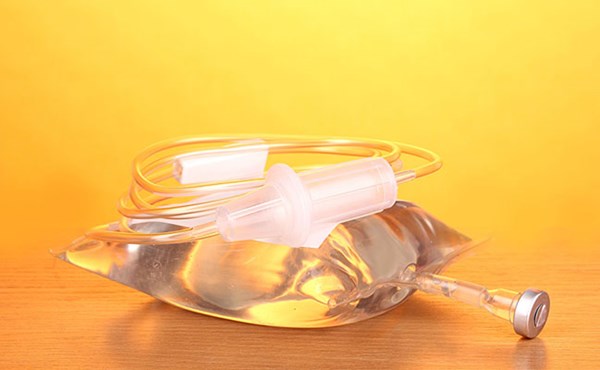Article
Jackson KE, Wang L, Casey JD, SMART Investigators and hte Pragmatic Critical Care Research Group, et al. Effect of Early Balanced Crystalloids Before ICU Admission on Sepsis Outcomes. Chest. 2021;159(2):585-595.
OBJECTIVE
To evaluate the impact on sepsis outcomes of fluid composition during early resuscitation in the ED vs after ICU admission
BACKGROUND
Intravenous (IV) fluid resuscitation has accumulated significant debate over the past 10 to 20 years with a focus on balanced fluid resuscitation (Lactated Ringers and Plasmalyte) as opposed to normal saline. Smaller studies including SALT and SPLIT found no significant difference in clinical outcomes between balanced . On the other hand, larger trials including SALT-ED and SMART with significantly larger sample sizes both reported lower rates of death, new renal replacement therapy, and persistent renal dysfunction with balanced In addition, no studies have focused on the effect of initiating balanced fluid resuscitation in the emergency department (ED) and are primarily focused on fluid resuscitation from the time point of ICU admission. This study presents the first trial to focus on the effect of starting balanced fluid resuscitation in the ED on sepsis outcomes.
DESIGN
Secondary analysis of the SMART Trial which was a pragmatic, unblinded, cluster-randomized, multiple-crossover trial with two recruitment periods, one recruiting from the time of ICU admission, and the other from time of ED presentation
POPULATION
Inclusion Criteria
- Patients admitted to Medical ICU with diagnosis of sepsis during the SMART trial
- Diagnosis of sepsis based on ICD-10 codes
Exclusion Criteria
- Patients admitted to cardiovascular, neurologic, surgical, and trauma ICU
- This was due to patients in these ICUs were only enrolled during the ICU-only portion of the original SMART trial
INTERVENTION and CONTROL
- 15,802 patients in SMART data set
- 1,641 admitted to Medical ICU with a diagnosis of sepsis
- INTERVENTION: 1,274 enrolled during ED and ICU period (January 2016 - March 2017)
- CONTROL: 367 enrolled during ICU only period (January 2015 - December 2015)
OUTCOMES
Primary
- Death from any cause before the first of either hospital discharge or 30 days after ICU admission
Secondary
- ICU-free days
- Ventilator-free days
- Vasopressor-free days
- Renal replacement therapy-free days
- Persistent renal dysfunction
- Final inpatient Cr. > 200% of baseline
- KDIGO Stage 2 or greater Acute Kidney Injury
- New receipt of renal replacement therapy
- Major adverse kidney event within 30 days
- Composite of death, new receipt of renal replacement therapy, or persistent renal dysfunction
KEY RESULTS
Primary Outcome
- ICU Only Period
- 30-day in-hospital mortality occurred in 47 (33.1%) of patients in the balanced crystalloid group vs 74 (32.9%) in the saline group (OR, 1.14;95% CI, 0.7 - 1.88)
- ED and ICU Period
- 30-day in-hospital mortality occurred in 170 (24.9%) of patients in the balanced crystalloid group vs 181 (30.6%) in the saline group (OR, 0.68; 95%, 0.55-0.89
- The p-value for interaction of the two groups above = 0.07
Secondary Outcomes
- Significantly more ICU-free days in balanced crystalloid groups in the ED initiation group (p=0.02).
- No significant difference in ventilator-free days, vasopressor-free days, renal replacement-free days, or incidence of major adverse kidney events within 30 days between ICU group and ED-ICU group.
STRENGTHS
- Use of data from a clinical trial increases likelihood of obtaining similar groups at baseline and minimizes risk of indication bias.
- SMART trial design allowed for unique evaluation of the effect of early balanced fluid resuscitation.
- Patients with sepsis were a pre-specified subgroup of interest in the original SMART trial design.
- Focused on medical ICU patients with sepsis, a specific subgroup hypothesized to benefit more from balanced fluid resuscitation.
- Broad variety of sources of sepsis in terms of infections (pulmonary, urinary, intra-abdominal, skin/soft tissue, blood stream, other).
- Baseline illness severity is similar across all groups (vasopressor requirement, mechanical ventilation).
LIMITATIONS
- SMART trial was unblinded.
- SMART trial was at a single center, limiting generalizability.
- ICD-10 codes used to identify sepsis, generally not available at baseline and organ dysfunction could theoretically develop after treatment allocation.
- Time periods were not randomized.
- Use of saline after ICU transfer may have decreased the separation between groups.
- Carrier fluids (i.e. for medications) were not accounted for and can contribute to significant amounts of daily fluid intake.
- Post-hoc analysis makes findings susceptible to type I error.
EM TAKE-AWAYS
Resuscitation of patients in septic shock is foundational to emergency physicians, and the best practices are still being evaluated and re-evaluated with new recommendations coming every few years. Intravenous fluid resuscitation has been a point of significant research through various trials (SALT, SALT-ED, SPLIT, SMART), and with more data comes more evidence that fluid choice in resuscitation matters.
In this study, investigators examined new data from the SMART trial and focused on the effect of choosing balanced fluid resuscitation in the emergency department as opposed to waiting until patients are in the ICU. The data further supports that choosing the right fluid, balanced crystalloids, may provide a mortality benefit, specifically in patients with sepsis. Emergency physicians and intensivists alike are coming to the same conclusion: Fluid choice matters.
References
- Semler MW, Wanderer JP, Ehrenfeld JM, et. al. Balanced crystalloids versus saline in the intensive care unit: the SALT randomized trial. Am J Respir Crit Care Med. 2017;195(10):1362-1372.
- Young P, Bailey M, Beasley R, et. al. Effect of a buffered crystalloid solution vs saline on acute kidney injury among patients in the intensive care unit: the SPLIT randomized clinical trial. JAMA. 2015;314(16):1701.
- Self WH, Semler MW, Wanderer JP, et al. Balanced Crystalloids versus Saline in Noncritically Ill Adults. N Engl J Med. 2018; 378(9):819-828. PMID: 29485926.
- Semler M, Self W, Wanderer J, Ehrenfeld J, Wang L, Byrne D et al. Balanced Crystalloids versus Saline in Critically Ill Adults. N Engl J Med. 2018;378(9):829-839.




